In this issue:
Powdery Mildew of Tomato
Basil Downy Mildew
Potato Leafhopper
Cabbage Worms
Spinach and Beet Leafminer
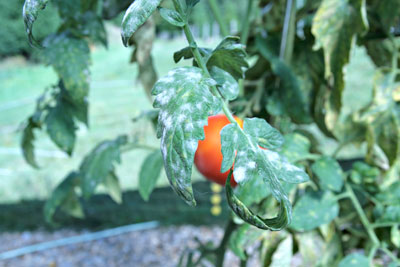 |
| Powdery mildew on tomato. Eric Sideman photo |
POWDERY MILDEW OF TOMATO – by Caleb Goossen, modification of Meg McGrath article
Powdery mildew has been reported on tomato transplants in Vermont and Massachusetts as well as on some greenhouse cucumbers this spring. Powdery mildews are very host specific which means that growers are already seeing at least two different species. There are some indications that this year’s powdery mildew on greenhouse tomatoes started with purchased transplants, which is a good reminder to start your own plants when you can, and to exercise caution and discretion when buying in plants! Most often, powdery mildews require a living host to reproduce, so it may be worthwhile to “quarantine” any bought-in plants for a few days to check for symptom development before planting into a clean greenhouse.
Meg McGrath from Cornell Cooperative Extension shared the following advice for keeping powdery mildew in check in tunnels and greenhouses:
Fungicides are the primary management tool for managing powdery mildew, the most common disease in high tunnel and greenhouse tomatoes. Micronized sulfur (e.g. Microthiol Disperss) and mineral oil (JMS Stylet-oil) are the most effective products for organic production based on comments from growers.
Sulfur is recommended applied at its lowest label rate because plants grown in protected culture tend to be more sensitive to phytotoxicity than field-grown plants. Also, without rain or overhead irrigation, fungicide residue will remain longer on plant tissue. As stated on the labels for these fungicides, there needs to be a gap of 2 or 3 weeks between applications of these products because oil can move sulfur into the leaf resulting in damage. Applications of sulfur especially during the harvest period may leave visible residue on fruit. It can be easily wiped off. An option to minimize visible residue is to use sulfur for the first applications until fruit start to mature, switch to another product for an application or two, then start applying oil.
Other organic-approved products that are not oils include MilStop, Cease (these two recommended used together), Double Nickel, M-Pede (apply at 3/4 rate to avoid phytotoxicity) and Regalia.
Cultural practices to add to the powdery mildew management program, which of course should be the first line of defense, include using wide in-row and between-row spacing of plants, and removing lower leaves. These will help reduce humidity and also improve spray coverage. Also, promote air movement to reduce humidity by opening sides or vents on warm days and using fans. Also, be sure to control perennial weeds which may serve as an overwintering host. These practices will help manage other foliar diseases including Botrytis gray mold and leaf mold.
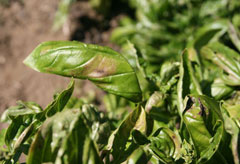 |
| Downy mildew of basil. Eric Sideman photo |
BASIL DOWNY MILDEW
It is very early in the season to be mentioning this problem, but once again long distance marketing from large corporations may create an issue, so let’s be careful. Seedlings that are already infected with basil downy mildew are sometimes sold, and so it is possible that gardeners all over can introduce the pathogen to their fields. The extent of the spread will depend on weather conditions. Be on the lookout if you purchase seedlings.
This is a pretty new problem, and it has been widespread the past few growing seasons. Downy mildew of basil was first reported in Uganda back in 1930. Recently it has been getting lots of attention as it spreads, first to Italy in 2004, France in 2005, United States (Florida) in 2007 and by 2009 New England.
The first symptom is a pale yellowing of the upper surface of the leaves, quite similar to sunscald. Later, vein-bounded patches of dark spore production can be seen on the lower surface. This develops into a gray, fuzzy growth typical of downy mildews of other crops. At first you may be able to convince yourself that some soil has been splashed onto the underside of the leaf, but soon the plants will be going down and it will be clear that it is not a problem that can be washed away.
The disease may be seed borne, but that is probably a very rare event. The spread in most likely due to the wind blown spores. In the damp conditions of the early and mid summer they could move far and wide. There is also some belief that seedlings already infected and moved across country for sale play a role. And this year it again seems like some outfits are selling plants already infected.
The infected leaves are safe to eat, and I have a report from a grower that mildly infected leaves still made a fine tasting pesto. Some types of basil are less or not susceptible at all. For example, my Thai basil is always fine. I have heard from a grower that the lemon basil is not susceptible, and that the purple basil seems a bit less susceptible. The common sweet basil is the most susceptible. If you have this problem, and you grow more than one type of basil, please keep records and let me know if you see any resistance so we can make some recommendations for next year. I have heard that Dolly is very susceptible and went down even though the other sweet basil varieties in the field were fine. The folks at Johnnys and lots of others are working hard to get resistant varieties and have some in their catalogs noting some resistance. For now, if you see downy mildew on the variety you are growing, make pesto fast.
There are relatively few fungicides labeled for herbs. Also, I have not seen reports of efficacy of any. Some copper fungicides are labeled. Other OMRI listed products that are labeled for herbs include Actinovate AG, Trilogy, and OxiDate. But, again, I do not have any evidence that they are effective. If you try any of these, leave some plants untreated so we can get some information.
For now, anything that will make the leaves dry quickly will help, e.g., weed control, good spacing, venting tunnels, watering in the morning instead of the evening, etc. I make new plantings every 3-4 weeks in hopes that if the spores come in and infect one planting I can destroy it so it does not release spores, and I have another planting waiting in the wings.
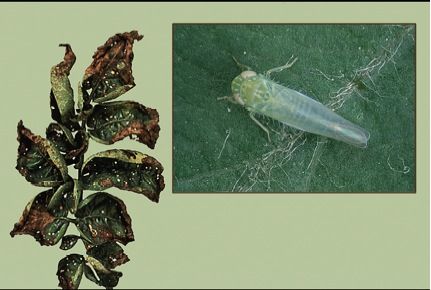 |
| Potato leaves damaged by leafhoppers (left) with leafhopper (right) greatly enlarged. |
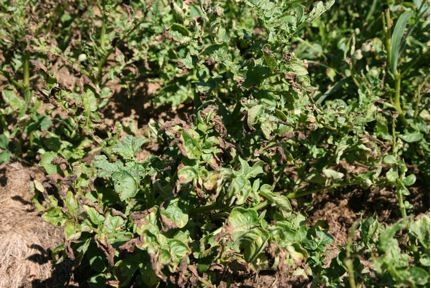 |
| Leafhopper damage on potato leaves, called “hopperburn.” |
POTATO LEAFHOPPERS
The potato leafhopper has been arriving here in New England earlier and earlier. If you see unexplained yellowing of leaves of beans or potatoes, check for the critter.
They primarily feed on beans, potatoes, eggplants, strawberries and alfalfa. PLH does not over winter anywhere near here. They over winter way down south on the coast of the Gulf of Mexico, and leapfrog up here in mass migrations. Sometimes hardly any make it, and other years there are massive numbers. Once they get here there are a few generations during the season and often become a bigger and bigger problem. The first to arrive are females, and they are usually carrying fertilized eggs when they get here. They first land in trees, but quickly search out vegetable crops.
The damage from leafhopper is catastrophic. The bug sucks the juice out of the plant and injects a toxin that clogs the food conducting tissue. The symptoms look like a disease after a while, rather than insect damage, and is frequently mistaken as such. The leaves first get pale, then yellow and then brown from the edges. Then the plant dies. The symptoms are called hopperburn.
The adult PLH is very light green and wedge shaped and tiny (an eighth of an inch long). The best way to find them is to brush the plant, see a bunch of this tiny things fly up, and watch one of the white-looking bugs land. The nymphs are similar to the adult, but have no wings and are even smaller. Nymphs live on the underside of the leaves. If you disturb a nymph you will see it run and it can run sideways as fast as forward. This is a clue that you have PLH and not some other less harmful species of leafhopper.
The adults are flighty. When you brush your crop you will see them fly up. If there is a cloud of them, you are in trouble. Researchers have developed a threshold before treatment is recommended. Thresholds vary but here is one that is typical: Treat potatoes if 5 adults or 15 large larvae are found on 50 leaves.
Crop rotation does nothing for you since they are coming from far away. Covering your crops with a row cover would work, but these crops are not the type that are usually covered. Effective insecticides are limited. The only material that I have seen work that is allowed in organic production is pyrethrum, so Pyganic is the recommendation that I make. Spray in the evening, get good coverage including the undersides of the leaves, and don’t wait until it is too late. If you wait to see leaf symptoms, it is too late. Plants will not recover.
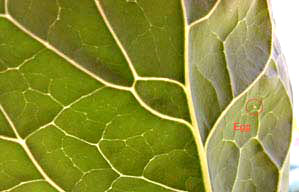 |
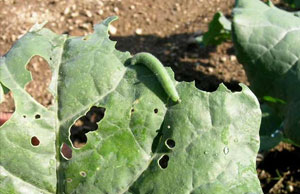 |
| Egg of imported cabbage worm (circled) | Imported cabbage worm |
IMPORTED CABBAGE WORM and others
The white butterfly with the dark marks on its wing that are flying in large numbers around the vegetables now is a troubling sight. They are very numerous already in some locations. Becky can find the eggs they lay, and the tiny caterpillars that hatch. I only notice them after I see the holes and chunks chewed out of the leaves. That has not happened yet, but the moths are laying eggs.
The imported cabbage worm is the most common of the three different caterpillars often found feeding on cabbage, broccoli, Brussels sprouts, kale, etc. By the way, it also feeds on lettuce. The pest overwinters as a pupa in crop debris and is a common pest every year.
There are two other caterpillars often seen feeding on brassica crops; the diamondback moth and the cabbage looper. The looper does not overwinter in the north, and I find it the rarest of the brassica pests. Diamondback is said not to overwinter here, and may not, but things have changed since I started working for MOFGA in the 80s, and I think there is some possibility it does overwinter in Maine now. Anyway, it will probably be here soon. For the most part, these pests are carried up here with storms and quickly find crops on which to lay eggs. Hence problems from these two pests vary from year to year.
All three pests produce multiple generations each growing season. It is important to destroy the crop debris after harvest so as not to harbor future generations that will move onto your later plantings. Controlling cruciferous weeds will help. Row covers will work however these crops do not do well in heat so there could be problems. Netting (e.g. Proteknet) that allows more air movement works well on such cool weather plants.
Bt gives good control of all three caterpillars. Dipel DF is a common brand, and is OMRI listed. As usual, if you are a certified grower be sure that the formulation you use is approved for organic production. Spinosad (e.g., Entrust, Monterey Garden Spray) works even better, but is more expensive. Be sure to scout the crops and spray only when the pest is present. Bt must be eaten to work and since it degrades quickly in sunlight it should be sprayed only when the pest is actively feeding. There is no protective activity, so there is no point in spraying until you see the caterpillars.
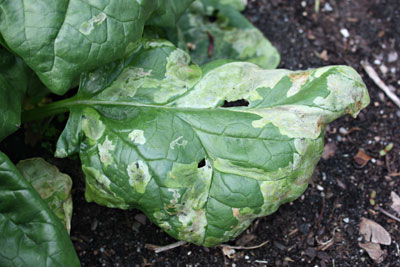 |
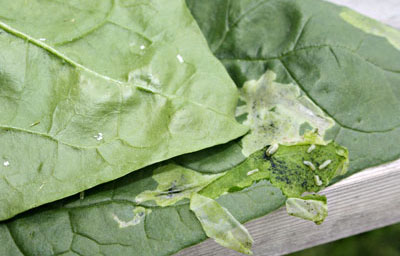 |
| Spinach leafminer damage | Spinach leafminer maggots |
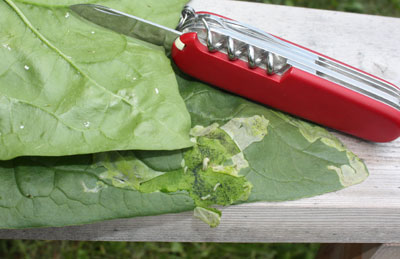 |
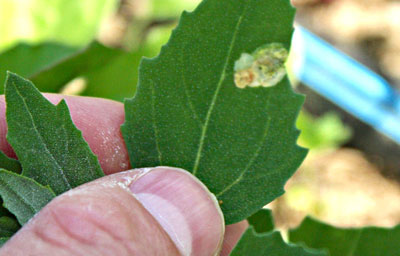 |
| Spinach leafminer maggots | Spinach leafminer damage on lambsquarters. Caleb Goossen photos |
SPINACH LEAFMINERS (beet leafminer, Pegomya betae, and spinach leafminer, Pegomya hyoscyami)
I hate to say it but it seems we have another pest that is becoming a regular problem. This is the second year that leaf miners have been really bad in spinach, chard, beets, etc. There are two species around here, and both of these pests attack spinach, beet, chard, and some weeds, such as lambsquarters.
The spinach leafminer is more common in the east. The adult is a fly that lays its eggs on the under- sides of leaves. The eggs hatch in as few as three days, depending on temperature. The tiny, pale maggots tunnel into the interior of the leaf to feed on cells, leaving pale mines that, when numerous, run together to form necrotic, blister-like areas (see photos in the web version). The damage is usually cosmetic, not impacting yield, BUT, it ruins the marketability of greens such as chard or spinach, etc. When fully grown, the larvae drop out of the leaf to the ground and pupate in the soil. Leafminers overwinter in the soil as pupae and emerge in the mid spring. Rotation is really important, especially if you are trying to use netting or row covers to exclude the fly.
Controls include:
1. Destroying crops at the end of harvest and controlling weeds, especially lambsquarters, chickweed, and plantain, is important for reducing the number of overwintering pupae.
2. Deep plowing can bury pupae and reduce the number of emerging flies the following spring.
3. Row covers and netting if the ground is sure not to have overwintering pupae.
Materials Approved for Organic Production:
Since spinosad (Entrust) penetrates leaves to some extent, some farmers claim that it is effective against leafminers.
